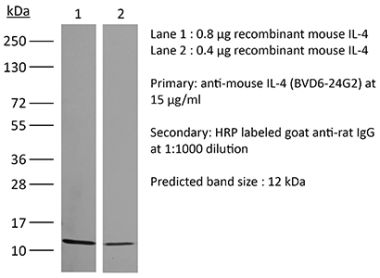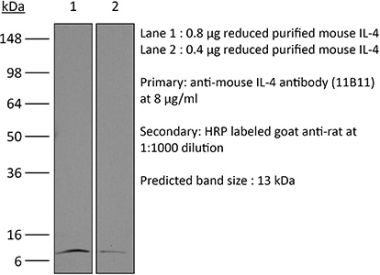InVivoMAb anti-human IL-4
Product Details
The MP4-25D2 monoclonal antibody reacts with human IL-4 (interleukin-4) a multifunctional 14 kDa cytokine. IL-4 is expressed primarily by activated Th2 cells and NK cells, and at lower levels by mast cells, and basophils. IL-4 signals through the IL-4Rα. Upon receptor binding IL-4 stimulates activated B and T lymphocyte proliferation, and the differentiation of B cells into plasma cells. It also induces B cell class switching to IgE, and up-regulates MHC class II production while decreasing the production of Th1 cells, macrophages, IFNγ, and dendritic cell IL-12. Like other Th2 associated cytokines, IL-4 is involved in the airway inflammation observed in the lungs of patients with allergic asthma. The MP4-25D2 monoclonal antibody has been shown to neutralize the bioactivity of natural or recombinant human IL-4.Specifications
| Isotype | Rat IgG1, κ |
|---|---|
| Recommended Isotype Control(s) | InVivoMAb rat IgG1 isotype control, anti-horseradish peroxidase |
| Recommended Dilution Buffer | InVivoPure pH 7.0 Dilution Buffer |
| Conjugation | This product is unconjugated. Conjugation is available via our Antibody Conjugation Services. |
| Immunogen | Recombinant human IL-4 expressing CHO cells |
| Reported Applications |
in vitro IL-4 neutralization Flow cytometry |
| Formulation |
PBS, pH 7.0 Contains no stabilizers or preservatives |
| Endotoxin |
<2EU/mg (<0.002EU/μg) Determined by LAL gel clotting assay |
| Purity |
>95% Determined by SDS-PAGE |
| Sterility | 0.2 µm filtration |
| Production | Purified from cell culture supernatant in an animal-free facility |
| Purification | Protein G |
| RRID | AB_2687722 |
| Molecular Weight | 150 kDa |
| Storage | The antibody solution should be stored at the stock concentration at 4°C. Do not freeze. |
Recommended Products
in vitro IL-4 neutralization
Li, L., et al. (2019). "TLR8-Mediated Metabolic Control of Human Treg Function: A Mechanistic Target for Cancer Immunotherapy" Cell Metab 29(1): 103-123.e105. PubMed
Regulatory T (Treg) cells induce an immunosuppressive microenvironment that is a major obstacle for successful tumor immunotherapy. Dissecting the regulatory mechanisms between energy metabolism and functionality in Treg cells will provide insight toward developing novel immunotherapies against cancer. Here we report that human naturally occurring and tumor-associated Treg cells exhibit distinct metabolic profiles with selectivity for glucose metabolism compared with effector T cells. Treg-mediated accelerated glucose consumption induces cellular senescence and suppression of responder T cells through cross-talk. TLR8 signaling selectively inhibits glucose uptake and glycolysis in human Treg cells, resulting in reversal of Treg suppression. Importantly, TLR8 signaling-mediated reprogramming of glucose metabolism and function in human Treg cells can enhance anti-tumor immunity in vivo in a melanoma adoptive transfer T cell therapy model. Our studies identify mechanistic links between innate signaling and metabolic regulation of human Treg suppression, which may be used as a strategy to advance tumor immunotherapy.
Flow Cytometry
Schulz, A. R., et al. (2015). "Low Thymic Activity and Dendritic Cell Numbers Are Associated with the Immune Response to Primary Viral Infection in Elderly Humans" J Immunol 195(10): 4699-4711. PubMed
Immunological competence declines progressively with age, resulting in increased susceptibility of the elderly to infection and impaired responses to vaccines. Underlying mechanisms remain largely obscure as they have been related to complex, individual systemic immune properties that are challenging to investigate. In this study, we explored age-related changes in human immunity during a primary virus infection experimentally induced by immunization with live-attenuated yellow fever (YF) vaccine. Applying detailed serology, advanced FACS analysis, and systems biology, we discovered that aged subjects developed fewer neutralizing Abs, mounted diminished YF-specific CD8(+) T cell responses, and showed quantitatively and qualitatively altered YF-specific CD4(+) T cell immunity. Among numerous immune signatures, low in vivo numbers of naive CD4(+) recent thymic emigrants and peripheral dendritic cells correlated well with reduced acute responsiveness and altered long-term persistence of human cellular immunity to YF vaccination. Hence, we reveal in this article that essential elements of immune responses such as recent thymic emigrants and dendritic cells strongly relate to productive immunity in the elderly, providing a conceivable explanation for diminished responsiveness to vaccination with neoantigens and infection with de novo pathogens in the aged population.
in vitro IL-4 neutralization
Nakatsukasa, H., et al. (2015). "The DNA-binding inhibitor Id3 regulates IL-9 production in CD4(+) T cells" Nat Immunol 16(10): 1077-1084. PubMed
The molecular mechanisms by which signaling via transforming growth factor-beta (TGF-beta) and interleukin 4 (IL-4) control the differentiation of CD4(+) IL-9-producing helper T cells (TH9 cells) remain incompletely understood. We found here that the DNA-binding inhibitor Id3 regulated TH9 differentiation, as deletion of Id3 increased IL-9 production from CD4(+) T cells. Mechanistically, TGF-beta1 and IL-4 downregulated Id3 expression, and this process required the kinase TAK1. A reduction in Id3 expression enhanced binding of the transcription factors E2A and GATA-3 to the Il9 promoter region, which promoted Il9 transcription. Notably, Id3-mediated control of TH9 differentiation regulated anti-tumor immunity in an experimental melanoma-bearing model in vivo and also in human CD4(+) T cells in vitro. Thus, our study reveals a previously unrecognized TAK1-Id3-E2A-GATA-3 pathway that regulates TH9 differentiation.
Flow Cytometry
Hong, M., et al. (2015). "Trained immunity in newborn infants of HBV-infected mothers" Nat Commun 6: 6588. PubMed
The newborn immune system is characterized by an impaired Th1-associated immune response. Hepatitis B virus (HBV) transmitted from infected mothers to newborns is thought to exploit the newborns’ immune system immaturity by inducing a state of immune tolerance that facilitates HBV persistence. Contrary to this hypothesis, we demonstrate here that HBV exposure in utero triggers a state of trained immunity, characterized by innate immune cell maturation and Th1 development, which in turn enhances the ability of cord blood immune cells to respond to bacterial infection in vitro. These training effects are associated with an alteration of the cytokine environment characterized by low IL-10 and, in most cases, high IL-12p40 and IFN-alpha2. Our data uncover a potentially symbiotic relationship between HBV and its natural host, and highlight the plasticity of the fetal immune system following viral exposure in utero.
Flow Cytometry
Gringhuis, S. I., et al. (2014). "Fucose-specific DC-SIGN signalling directs T helper cell type-2 responses via IKKepsilon- and CYLD-dependent Bcl3 activation" Nat Commun 5: 3898. PubMed
Carbohydrate-specific signalling through DC-SIGN provides dendritic cells with plasticity to tailor immunity to the nature of invading microbes. Here we demonstrate that recognition of fucose-expressing extracellular pathogens like Schistosoma mansoni and Helicobacter pylori by DC-SIGN favors T helper cell type-2 (TH2) responses via activation of atypical NF-kappaB family member Bcl3. Crosstalk between TLR and DC-SIGN signalling results in TLR-induced MK2-mediated phosphorylation of LSP1, associated with DC-SIGN, upon fucose binding. Subsequently, IKKepsilon and CYLD are recruited to phosphorylated LSP1. IKKepsilon activation is pivotal for suppression of CYLD deubiquitinase activity and subsequent nuclear translocation of ubiquitinated Bcl3. Bcl3 activation represses TLR-induced proinflammatory cytokine expression, while enhancing interleukin-10 (IL-10) and TH2-attracting chemokine expression, shifting TH differentiation from TH1 to TH2 polarization. Thus, DC-SIGN directs adaptive TH2 immunity to fucose-expressing pathogens via an IKKepsilon-CYLD-dependent signalling pathway leading to Bcl3 activation, which might be targeted in vaccination strategies or to prevent aberrant inflammation and allergy.
Flow Cytometry
Wevers, B. A., et al. (2014). "Fungal engagement of the C-type lectin mincle suppresses dectin-1-induced antifungal immunity" Cell Host Microbe 15(4): 494-505. PubMed
Recognition of fungal pathogens by C-type lectin receptor (CLR) dectin-1 on human dendritic cells is essential for triggering protective antifungal TH1 and TH17 immune responses. We show that Fonsecaea monophora, a causative agent of chromoblastomycosis, a chronic fungal skin infection, evades these antifungal responses by engaging CLR mincle and suppressing IL-12, which drives TH1 differentiation. Dectin-1 triggering by F. monophora activates transcription factor IRF1, which is crucial for IL12A transcription via nucleosome remodeling. However, simultaneous F. monophora binding to mincle induces an E3 ubiquitin ligase Mdm2-dependent degradation pathway, via Syk-CARD9-mediated PKB signaling, that leads to loss of nuclear IRF1 activity, hence blocking IL12A transcription. The absence of IL-12 leads to impaired TH1 responses and promotes TH2 polarization. Notably, mincle is similarly exploited by other chromoblastomycosis-associated fungi to redirect TH responses. Thus, mincle is a fungal receptor that can suppress antifungal immunity and, as such, is a potential therapeutic target.







